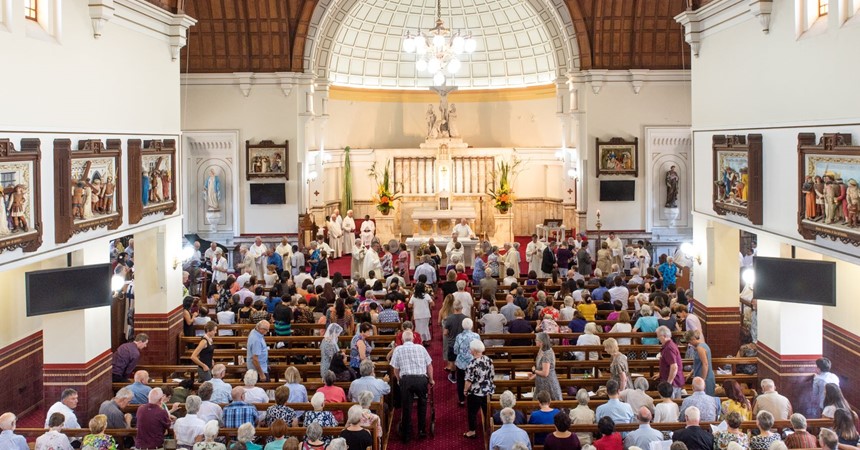Before proceeding you might like to gather your reflections from the first, second, third, fourth and fifth articles in this series.
Our journey of paying attention to the liturgy continues to be guided by our three mystagogical questions
- What do you notice?
- What does it reveal to you/us (about God, Christ, the church, the liturgy …)?
- What does it ask of you/us?
This process of reflection helps us open our eyes and hearts to look afresh at what is so familiar that we can miss the mystery it is meant to reveal and the conversion to which it calls us.
Let us begin by listening to a couple of hymns. What we sing during Communion is very important. We sing our faith. We sing words that help us know ourselves as celebrants NOT consumers, as a community NOT individuals. As participants NOT adorers.
As a diocesan community we have been learning From the Many Make us One by Tony Alonso. The refrain is:
Ref: When we sing and when we cry,
as we live and as we die:
To this table now we come.
From the many make us one.
Tune: Tony Alonso, © 2015 GIA Publications, Inc. Text: Gabe Huck, © 2015 GIA Publications, Inc. Reprinted with permission under ONE LICENSE #A-624954. All rights reserved.
A favourite in our repertoire is One Love Released by K. Keil & B. Frenzel, the refrain of which is:
Ref: One bread, one body, one cup, one call,
One faith, one spirit present in us all.
One prayer, one blessing, one hope, one peace,
One church, one people, one love released.
Text and music © 1999, 2000, Robert H. Frenzel and Kevin Keil. Published by OCP. Reprinted with permission under ONE LICENSE #A-624954. All rights reserved.
What did you notice? What is God revealing to us in these Communion hymns? Hold your reflections as we proceed.
It is important to be aware of the context of Communion. As we know, it is the fourth part of the four-part eucharistic action: take – bless – break – give. This action begins and ends with a procession. In the first procession the faithful present the gifts to be taken, blessed, broken and given. In the second procession the faithful are given the bread of life and the cup of salvation, that is, we receive who we have become in Christ. There’s a lot to ponder here.
Communion is also part of the smaller unit known as the Communion Rite, a rite that is all about unity. Recall the hymns above.
Within this context, Communion is essentially an action we do together: we watch, listen, process, sing, engage in dialogue. These are the modes of our full, conscious and active participation.
With these things in mind let us turn our attention to the texts and rubrics of the Missal and the General Instruction of the Roman Missal (GIRM). As we’ve noted previously, liturgy is not the texts, it is the celebration. So as you ponder the texts, imagine the liturgical action and perhaps the last time you participated in it. Does the whole liturgy – text and ritual action – invite our participation as celebrants or consumers?
Click here to read the relevant texts.
Reflection
This reflection presumes the liturgy celebrated in its fullness without the current COVID-19 restrictions.
The liturgy works through signs perceptible to the senses and in ways appropriate to those signs. (CSL a. 7)
In regard to Eucharist, Communion in particular, the central sign/symbol that needs to be perceptible to our senses is a shared meal: a meal in which the community gathers around one table, to eat from one loaf and drink from one cup.
A shared meal, of its nature, is communal. As celebrants the mode of our individual participation needs to convey this. As celebrants we are attentive to our brothers and sisters with whom we share this meal. The Communion procession – from beginning to end – is the focus of our attention. We watch and pray for each one of our brothers and sisters as they come to the table to eat and drink. While there is a personal dimension to Communion, it is not a private ‘me and God’ moment. The name ‘communion’ reveals its nature. This is essentially a communal, unifying time. We receive Communion to become a communion.
As a sharing-in-one-meal, the ritual actions endeavour to unite the communion of the presider with that of the lay faithful. Having received Communion, the presider moves directly to distribute Communion to the faithful. The Communion hymn assists in establishing this unity. It begins with the presider’s Communion and continues until the Communion procession is finished.
Communion is a time for singing, not for quiet music. Uniting our voices in song strengthens the sense of this being a communal action. Quiet music during the Communion procession reinforces Communion as private ‘me and God’ time.
If the central ‘sign’ is that we are sharing in the one meal by eating from the one loaf, then as a. 85 of the GIRM indicates, all the lay faithful, like the presider, ought to receive Communion from the altar and NOT from the tabernacle. We receive from our sacrifice, not from that of another community. We presented the offerings and we receive who we have become through, with and in Christ and in the power of the Holy Spirit. The two processions balance each other. We can only receive because we have in the first instance given ourselves to be joined to Christ’s offering. The whole church is changed in the celebration of Eucharist. For presiders to deny the lay faithful of this full, conscious and active participation is to reduce them to the status of consumers. The ritual signs need to be bold and expansive if they are to embody the mystery they are meant to reveal.
To participate in Communion as celebrants demands everything of each one of us. The moment I approach the minister, when I extend my hands and engage in that simple dialogue, is a moment of deep encounter that is life changing. I need, and ideally can feel, the love and pray of my brothers and sisters supporting me as I muster the courage to say ‘Amen’ to the proclamation ‘The body of Christ’ and ‘The blood of Christ’. I receive the body and blood of Christ as a sign of my commitment to live as a member of the body of Christ. I am making a public commitment, not alone, but a part of the assembly of God’s faithful people. This is too big to do alone. We must do it together.
Are we participating in the celebration of Eucharist as celebrants or consumers? It matters. As celebrants we gather as a community not as a group of individuals. As celebrants we come to offer ourselves with Christ to God, to be taken, blessed, broken open and poured out, and given in love for the life of the world. These are the steps at the heart of the Paschal Mystery. As celebrants we come to Eucharist to learn the steps that we are called to live, day in and day out.
The integrity of the liturgy as a celebration of the faithful and the integrity of our lives as a communion of missionary disciples are inextricably linked. The ‘Liturgy of the Eucharist’ demands that we participate as celebrants not consumers.
One prayer, one blessing, one hope, one peace,
One church, one people, one love released.
What are you pondering? What insight has your reflection led you to? To what change is God inviting you and us, both as celebrants of liturgy and life?
You might like to:
- Read the ‘Diocesan Guidance on the Communion Rite at Mass’. This document is being revised in light of conversations across the diocesan community last year. The updated version will be available soon.
- Reflect on St Augustine’s famous homily ‘Your own Mystery’.
- Read these articles by Thomas O’Louglin:
Coronavirus and the Eucharist
After the virus: Liturgy and accountability - View the videos in the ‘Flashes if Insight: let’s talk liturgy’ series’.
Abbreviations
CSL: The Constitution on the Sacred Liturgy
GIRM: General Instruction of the Roman Missal
Acknowledgements
Prayers and references to the General Instruction of the Roman Missal are from the English Translation of the Roman Missal © 2010 International Committee on English in the Liturgy Inc. (ICEL). All rights reserved.
Photo: © Diocese of Maitland-Newcastle. All rights reserved.

